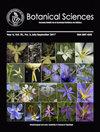具有膜翅目传粉综合征的五种盘盏花的花形态变异
IF 0.7
4区 生物学
Q3 PLANT SCIENCES
引用次数: 4
摘要
背景:地理距离通过促进环境距离、限制基因流动和使植物暴露于不同的花粉载体而促进表型变异。因此,了解植物形态如何在地理范围内发生变化,有助于我们在宏观和微观进化尺度上理解形态多样化的驱动因素。问题:1)地理位置和非生物因素如何影响种群间的花形态?2)花卉形态变异是否存在地理格局?3)年温度和降水变化对种群内花形态的影响;研究地点和时间:美国大陆,2017年和2018年夏季。方法:随机选取57个种群、496个个体,测定10个花性状。生物气候变量提取自WorldClim数据库和NOAA。采用线性模型、偏最小二乘回归、Mantel检验和典型相关分析对数据进行分析。结果:地理变量单独解释了两个物种花形态的很大一部分差异,而其他物种的花形态在地理距离大的情况下没有变化。花的大小由南向北增大,而花的大小则由东向西增大。年平均降水量是影响鹅毛花形态的最重要变量。结论:地理距离有利于种群间的距离隔离和物候隔离,也有利于种群间的非生物差异;然而,其他因素,如传粉者,可能使种群在地理距离大的情况下保持形态同质。本文章由计算机程序翻译,如有差异,请以英文原文为准。
Flower morphology variation in five species of Penstemon (Plantaginaceae) displaying Hymenoptera pollination syndrome
Background: Geographic distance promotes phenotypic variation by facilitating environmental distance, limiting gene flow, and exposing plants to different pollen vectors. Therefore, understanding how plant morphology changes across a geographic range improves our understanding of the drivers of morphological diversification both on a macro- and micro-evolutionary scale.
Questions: 1) How do geographic location and abiotic factors affect flower morphology between populations? 2) Is there a geographic pattern of flower morphology variation? and 3) How does yearly variation in temperature and precipitation affect flower morphology within populations?
Studied species: Penstemon albidus, P. fruticosus, P. glandulosus, P. speciosus, and P. whippleanus
Study site and dates: The continental USA, summers of 2017 and 2018
Methods: Fifty-seven populations and 496 individuals were selected at random to measure ten floral traits. Bioclimatic variables were extracted from the WorldClim database and NOAA. Linear models, partial least squares regression, Mantel tests and canonical correlation analysis were used to analyze the data.
Results: Geographic variables alone explained a significant portion of the variation in flower morphology in two species, while in others, flower morphology did not vary despite large geographic distances. Penstemon albidus and P. whippleanus flowers increase in size from south-north, while P. glandulosus and P. speciosus exhibited an east-west increasing trend. Additionally, mean annual precipitation was the most important variable influencing P. glandulosusflower morphology.
Conclusions: Geographic distance facilitates isolation-by-distance and isolation-by-phenology as well as abiotic differences between populations; however, other factors such as pollinators might be keeping populations morphologically homogeneous despite large geographic distance.
求助全文
通过发布文献求助,成功后即可免费获取论文全文。
去求助
来源期刊

Botanical Sciences
Agricultural and Biological Sciences-Plant Science
CiteScore
1.90
自引率
21.40%
发文量
71
审稿时长
16 weeks
期刊介绍:
Botanical Sciences welcomes contributions that present original, previously unpublished results in Botany, including disciplines such as ecology and evolution, structure and function, systematics and taxonomy, in addition to other areas related to the study of plants. Research reviews are also accepted if they summarize recent advances in a subject, discipline, area, or developmental trend of botany; these should include an analytical, critical, and interpretative approach to a specific topic. Acceptance for reviews will be evaluated first by the Review Editor. Opinion Notes and Book Reviews are also published as long as a relevant contribution in the study of Botany is explained and supported.
 求助内容:
求助内容: 应助结果提醒方式:
应助结果提醒方式:


